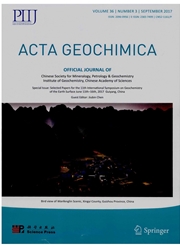

 中文摘要:
中文摘要:
在 Belog 公司区域的晚第三纪火山岩, Qiangtang,北西藏,被一个典型中介基本、中间的碱性岩协会代表, withlatite-trachyte 作为主要岩石类型。化学分析的结果是:SiO2=52%-62%,Al2O3】15%, Na2O/K2O】1 和 MgO【3.30%.In 增加,火山岩是 LREE-enrichedwith LREE/HREE=10-13 ,( La/Yb ) N=15-19 ,并且在Mg#和 SiO2 和象 La/Sm-La 和 Cr-Tb 那样的 magmatophile 元素 andultra-magmatophile 元素的共变之间的三角洲 Eu=0.71-0.89.Theclose 关系地显示出一个弱否定 Eu 异例显示火山岩的这个协会是 comagmatic 的产品分离结晶。岩石协会类型和 lowerSm/Yb 价值(Sm/Yb=3.23-3.97 ) 暗示火山岩的这个协会应该从在石版印刷的尖晶石 lherzolite 的部分融化发源球的披风。在另一方面,在 Nb, Ta 和 Ti 的弱否定 Eu 异例和相对弄空反映晚第三纪 Belog 公司碱的火山岩应该是的 terrigenousmagma.So 的特征在 Qinghai 西藏高原上的特殊外壳披风过渡带的部分融化的结果。
 英文摘要:
英文摘要:
Neogene volcanic rocks in the Belog Co area, Qiangtang, northern Tibet, are represented by a typical intermediate-basic and intermediate alkaline rock association, with latite-trachyte as the main rock type. The results of chemical analysis are: SIO2=52%-62%, A1203〉15%, Na20/KzO〉l and MGO〈3.30%. In addition, the volcanic rocks are LREE-enriched with LREE/HREE=10-13, (La/Yb)N=15-19, and show a weak negative Eu anomaly with 8Eu=0.71-0.89. The close relationship between Mg# and SiO2 and the co-variation of the magmatophile elements and ultra-magmatophile elements such as La/Sm-La and Cr-Tb indicate that this association of volcanic rocks is the product of comagmatic fractional crystallization. The rock association type and lower Sm/Yb values (Sm/Yb=3.23-3.97) imply that this association of volcanic rocks should have originated from partial melting of spinel lherzolite in the lithospheric mantle. On the other hand, the weak negative Eu anomaly and relative depletion in Nb, Ta and Ti reflect the features of terrigenous magma. So the Neogene Belog Co alkaline volcanic rocks should be the result of partial melting of the special crust-mantle transition zone on the Qinghai-Tibet Plateau.
 同期刊论文项目
同期刊论文项目
 同项目期刊论文
同项目期刊论文
 Genesis of the Madang Cenozoic sodic alkaline basalt in the eastern margin of the Tibetan plateau an
Genesis of the Madang Cenozoic sodic alkaline basalt in the eastern margin of the Tibetan plateau an Partial melting of thickened Tibetan crust: geochemical evidence from Cenozoic adakitic volcanic roc
Partial melting of thickened Tibetan crust: geochemical evidence from Cenozoic adakitic volcanic roc Geochemistry and Sr-Nd-Pb isotopic characteristics of the Mugouriwang Cenozoic volcanic rocks from T
Geochemistry and Sr-Nd-Pb isotopic characteristics of the Mugouriwang Cenozoic volcanic rocks from T 期刊信息
期刊信息
